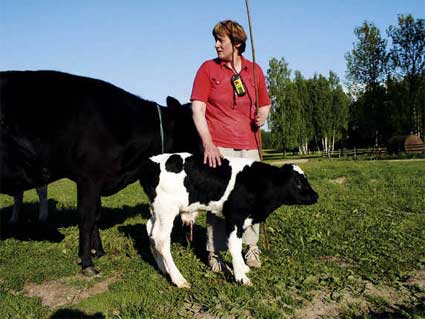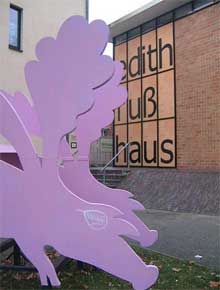 One of my favourite exhibition spaces for new media art is the Edith Russ Haus in Oldenburg (Germany). It’s hell to get there from Berlin. Hell as in 3 different trains and although they are the usual super comfortable kind you expect from the German railway services, it’s still a total of 7 hours spent in stations and wagons for a return trip. But once you’re back from Oldenburg, there isn’t any doubt left: the quality of the show was worth the transport tedium.
One of my favourite exhibition spaces for new media art is the Edith Russ Haus in Oldenburg (Germany). It’s hell to get there from Berlin. Hell as in 3 different trains and although they are the usual super comfortable kind you expect from the German railway services, it’s still a total of 7 hours spent in stations and wagons for a return trip. But once you’re back from Oldenburg, there isn’t any doubt left: the quality of the show was worth the transport tedium.
The current exhibition, Ecomedia – Ecological Strategies in Today’s Art, was curated by Sabine Himmelsbach, Karin Ohlenschläger and Yvonne Volkart. It presents projects founded on progressive ecological models and conceive utopian horizons in the process. It peruses fundamental considerations concerning ecosystems, sustainability, renewable energy sources, as well as visions of the future. In addition, it examines the role of art and new media over and above science, technology, and ecoactivism. I liked the theme, the way the curators explored it but most of all i found that the works on show were of particularly good quality, individually and as a whole.
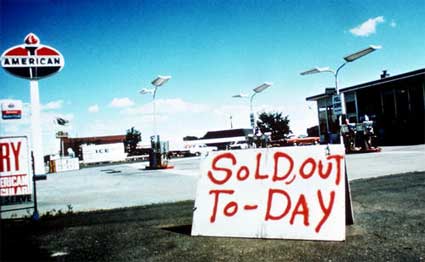 1973 oil crisis
1973 oil crisis
The work that moved me the most is Christina Hemauer‘s and Roman Keller‘s video and installation work, A Moral Equivalent of War: A Curiosity, a Museum Piece and an Example of a Road not Taken (2006-7). Reading news headlines yesterday, i realized how meaningful the work is. The title of the work, inspired by a television speech to the Nation delivered by Jimmy Carter in 1977, documents the artists’ quest for the solar panels that President Carter had mounted on the roof of the West Wing of the White House in 1979 during a moment of awareness of the dangers of the US’ dependence on foreign oil.
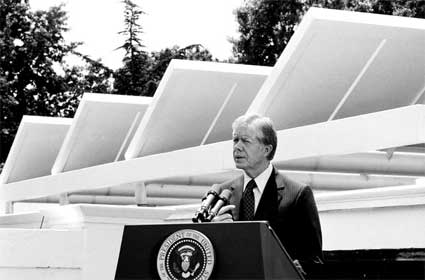 Dedication of the solar panels
Dedication of the solar panels
In 1977 Carter convinced the Democratic Congress to create the US Department of Energy. Promoting the department’s recommendation to conserve energy, Carter wore sweaters, had solar panels installed on the roof of the White House, had a wood stove in his living quarters, and requested that Christmas decorations remain dark in 1979 and 1980.
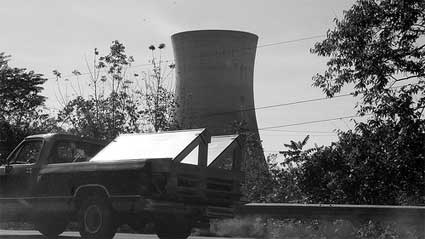 Christina Hemauer/Roman Keller: A Moral Equivalent of War, 2007. Image courtesy of Edith Russ Haus
Christina Hemauer/Roman Keller: A Moral Equivalent of War, 2007. Image courtesy of Edith Russ Haus
Carter called for 20 percent of American energy to come from solar power by the year 2000, he even had very generous tax reductions implemented for people who installed solar panels at home. But the Reagan administration in the 1980s put a stop to that, the panels and all their symbolic power were torn down and the energy budget was curtailed by 90%. 25 years later people are slowly starting to understand how foolish Reagan’s gesture was.
In 1991, «America’s Environmental College», Unity College in Maine, tracked the panels, found them in a warehouse just outside DC, bought them for peanuts and installed them on the roof of their dining room. Hemauer and Keller strapped one of the panels to the roof of their car and drove from Maine to the Jimmy Carter Library and Museum in Atlanta, filming a documentary along the way, interviewing people who had been involved in the solar panel experiment, and reopening a dialogue about present energy policy.
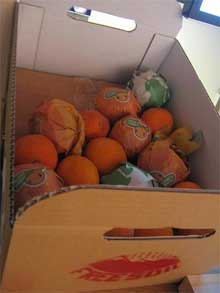 Just like A Moral Equivalent of War, The Acorn Pig Cinema, MILKproject and F.R.U.I.T. are projects which slap you in the face with all their relevance.
Just like A Moral Equivalent of War, The Acorn Pig Cinema, MILKproject and F.R.U.I.T. are projects which slap you in the face with all their relevance.
We keep reading that eating local food might not always be such a good idea. Sometimes the food is sent on huge globetrotting journeys whether the reason for the trip is that english prawns are cheaper when shelled in Asia or that lamb is four times more energy-efficient when imported from the other side of the world than when it is bought from a producer in your backyard. Eating local can have damaging effects on African organic farmers. You can’t make feta in Yorkshire and we should all start thinking about adopting a vegetable.
FRUIT, by Free Soil, invites visitors to take their ecological knowledge into their own hands, by becoming aware of the entire life of a product, from production to utilization, and not just what they see in the stores. Consumers must be aware that every phase of a product’s life influences the environment and ourselves. F.R.U.I.T wrappers, a website, and a traveling installation are part of an initiative to inform people about alternative food systems and local food movements.
Free Soil uses oranges as a vehicle to explore the complex relationships that make up the worlds Food Systems. The oranges –that Free Soil found at the Oldenburg local distributor– in Winter come from South Africa. This means that they have been underway at least one month by boat. This is also why it is practically impossible to have organic oranges at this time of year as most of them would rot if they were not treated chemically.
MILK, a project by Esther Polak, Ieva Auzina and Rixc, follows the milk from the cow to the table of the consumer. All the participants, from Latvian farmers to Dutch cheese makers and market salesmen, were given a GPS device for one of the days that saw them involved in the movements of the dairy product.
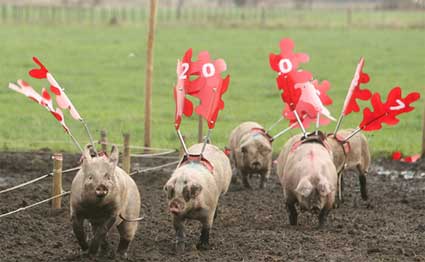 Insa Winkler: Das Eichelschwein Kino Mobil. Image courtesy of Edith Russ Haus
Insa Winkler: Das Eichelschwein Kino Mobil. Image courtesy of Edith Russ Haus
Insa Winkler‘s work intends to make us reflect on the globally implemented industrial farming.
In a mass production factory located Wülknitz, a municipality in Saxony (Germany), pigs destined to become Tyrolean bacon are fattened. Wülknitz is situated in a highly exploited mono-cultivated land and suffers greatly from an exodus of the population.
How is it that the famous Tyrolean bacon can make its name by means of anonymous pigs from Saxony? If these pigs can be made into Tyrolean bacon, then it should also be possible to produce a speciality of equal quality – the “Saxon acorn ham? – in a setting which is worth living in for both man and animal in compliance with the premises of the Agenda 21.
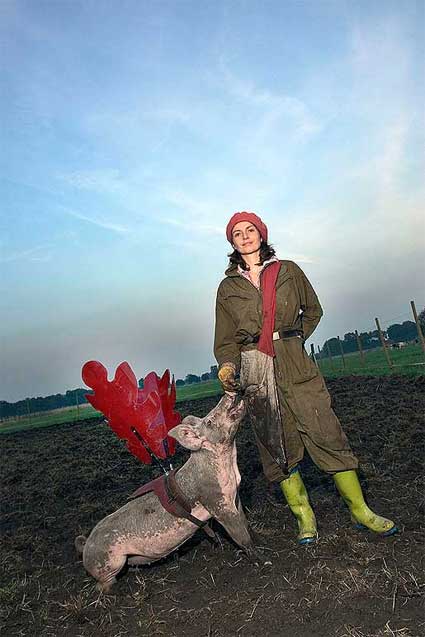
Insa Winkler interviewed farmers of conventional pig farming, studied the mechanisms of industrial meat production, the destruction of landscape with monoculture and fields for liquid manure, etc. She searched a piece of land around Wülknitz, got authorization to keep pigs outside, bought a special breed of pigs and learned how to raise and feed them on acorns. The ham from these pigs will be produced in a local factory, and then sold in local restaurants, throughout Germany and also internationally.
Raising piglets in acorn forests – like some parts of Spain still do today – is not just a romantic ideal, it can also be an important contribution for the biodiversity of landscape.
Insa Winkler created a logo and a public relation vehicle for her project: The Acorn Pig Cinema which transports the film from the Project since 2004.
Parallel to a public discussion, the practicality of The Acorn Pig as an agricultural project is explored, making it both an agricultural and a cultural experiment.
But what if we should keep on breeding, feeding and killing pigs industrially? Is there a way to keep the animal welfare element in the equation? Rotterdam architecture office MVRDV thinks so. The Pig City project, for which they collaborated with the Dutch Ministry of Agriculture, Nature and Fisheries, is a computer simulation of skyscrapers for industrial pig breeding.
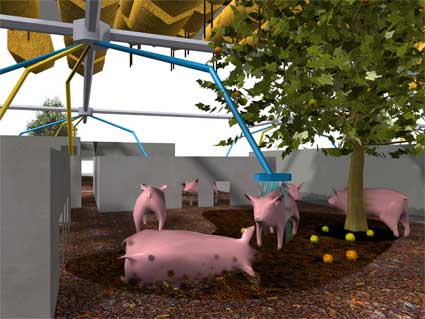 MVRDV: Pig City, 2000-2001. Image courtesy of Edith Russ Haus
MVRDV: Pig City, 2000-2001. Image courtesy of Edith Russ Haus
Pigs would inhabit stacked ‘apartments’, balconies would allow them to rummage around under trees outside. Pigs for slaughter would be moved in lifts and brought to a central abattoir housed in the plinth. On top, a fish farm would supply some of the food needed. Each tower contains a central slurry-processing plant and a biogas tank, which caters for the tower’s energy needs. To reduce transport costs, towers are located either in the port or close to major cities.
When first presented the project met with heavy discussions: criticism centred on the dangers of centralisation. Should one element be put out of operation, then the consequences for the whole system couldn’t be foreseen. There were also unfavourable comments about the belief that society can reduce nature into models that are then turned into reality. What is more, the pig flats would ‘harm’ the image of the pig-farming sector. Architecture critics in the media were much more receptive and viewed it as a courageous proposal.
Ecological Strategies in Today’s Art runs until January 13 at the ERH in Oldenburg, Germany. The show is a touring exhibition. It just opened at plug.in in Basel last week.
You can order the catalogue of Ecomedia for EUR 24,80 plus shipping costs from:
[email protected]
Set of images.
Ecological Strategies in Today’s Art (part 2)
Previous exhibition at the Edith Russ Haus: Soundbytes (part 1 and 2).
Related stories: Edible City, Part 1 and 2. Eyebeam’s Ecoviz Design Challenge panel (part 1), Eyebeam’s Ecoviz Design Challenge panel (part 2).

